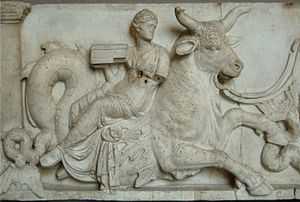Nereid
In Greek mythology, the Nereids (/ˈnɪəriɪdz/ NEER-ee-idz; Greek: Νηρηΐδες, sg. Νηρηΐς) are sea nymphs (female spirits of sea waters), the fifty daughters of Nereus and Doris, sisters to Nerites. They were distinct from the Sirens. They often accompany Poseidon, the god of the sea, and can be friendly and helpful to sailors fighting perilous storms.
Mythology

Nereids are particularly associated with the Aegean Sea, where they dwelt with their father in the depths within a silvery cave. The most notable of them are Thetis, wife of Peleus and mother of Achilles; Amphitrite, wife of Poseidon; and Galatea, lover of the Cyclops Polyphemus.
In Homer's Iliad XVIII, when Thetis cries out in sympathy for the grief of Achilles for the slain Patroclus, her sisters appear. The Nereid Opis is mentioned in Virgil's Aeneid. She is called on by the goddess Diana to avenge the death of the Amazon-like female warrior Camilla. Diana gives Opis magical weapons with which to take revenge on Camilla's killer, the Etruscan [[Arruns {Etruscan}|]]. Opis sees and laments Camilla's death and shoots Arruns in revenge as directed by Diana.[1]
Modern use
In modern Greek folklore, the term "nereid" (νεράϊδα, neráïda) has come to be used for all nymphs, or fairies, or mermaids, not merely nymphs of the sea.
The Nereids are the namesake of one of the moons of the planet Neptune.
Names

This list is correlated from four sources: Homer's Iliad,[2] Hesiod's Theogony,[3] the Bibliotheca, and Hyginus. Because of this the total number of names goes beyond fifty.[4]
- Actaea (Ἀκταίη)[2][3]
- Agaue (Ἀγαυὴ)[2][3]
- Amatheia (Ἀμάθεια)[2]
- Amphinome (Ἀμφινόμη)[2]
- Amphithoe (Ἀμφιθόη)[2]
- Amphitrite (Ἀμφιτρίτη)[3]
- Apseudes (Ἀψευδὴς)[2]
- Arethusa
- Asia
- Autonoe (Αὐτονόη)[3]
- Beroe
- Callianassa (Καλλιάνασσα)[2]
- Callianeira (Καλλιάνειρα)[2]
- Calypso
- Ceto
- Clio
- Clymene (Κλυμένη)[2]
- Cranto
- Creneis
- Cydippe
- Cymo (Κυμώ)[3]
- Cymatolege (Κυματολήγη)[3]
- Cymodoce (Κυμοδόκη)[2][3]
- Cymothoe (Κυμοθόη)[2][3]
- Deiopea
- Dero
- Dexamene (Δεξαμένη)[2]
- Dione[5]
- Doris (Δωρίς)[2][3]
- Doto (Δωτώ)[2][3]
- Drymo
- Dynamene (Δυναμένη)[2][3]
- Eione (Ἠιόνη)[3]
- Ephyra
- Erato (Ἐρατώ)[3]
- Euagore (Εὐαγόρη)[3]
- Euarne (Εὐάρνη)[3]
- Eucrante (Εὐκράντη)[3]
- Eudore (Εὐδώρη)[3]
- Eulimene (Εὐλιμένη)[3]
- Eumolpe
- Eunice (Εὐνίκη)[3]
- Eupompe (Εὐπόμπη)[3]
- Eurydice
- Galene (Γαλήνη)[3]
- Galatea (Γαλάτεια)[2][3]
- Glauce (Γλαύκη)[2][3]
- Glauconome (Γλαυκονόμη)[3]
- Halie (Ἁλίη)[2][3]
- Halimede (Ἁλιμήδη)[3]
- Hipponoe (Ἱππονόη)[3]
- Hippothoe (Ἱπποθόη)[3]
- Iaera (Ἴαιρα)[2]
- Ianassa (Ἰάνασσα)[2]
- Ianeira (Ἰάνειρά)[2]
- Ione
- Iphianassa
- Laomedeia (Λαομέδεια)[3]
- Leiagore (Ληαγόρη)[3]
- Leucothoe
- Ligea
- Limnoreia (Λιμνώρεια)[2]
- Lycorias
- Lysianassa (Λυσιάνασσα)[3]
- Maera (Μαῖρα)[2]
- Melite (Μελίτη)[2][3]
- Menippe (Μενίππη)[3]
- Nausithoe
- Nerea (Νερεα)
- Nemertes (Νημερτής)[2][3]
- Neomeris
- Nesaea (Νησαίη)[2][3]
- Neso (Νησώ)[3]
- Opis
- Oreithyia (Ὠρείθυια)[2]
- Panopea (Πανόπεια)[3]
- Panope (Πανόπη)[2]
- Pasithea (Πασιθέη)[3]
- Pherusa (Φέρουσά)[2][3]
- Phyllodoce
- Plexaure
- Ploto (Πλωτώ)[3]
- Polynome
- Pontomedusa
- Pontoporeia (Ποντοπόρεια)[3]
- Poulunoe (Πουλυνόη)[3]
- Pronoe (Προνόη)[3]
- Proto (Πρωτώ)[2][3]
- Protomedeia (Πρωτομέδεια)[3]
- Psamathe (Ψαμάθη)[3]
- Sao (Σαώ)[3]
- Speio (Σπειώ)[2][3]
- Thaleia (Θάλειά)[2]
- Themisto (Θεμιστώ)[3]
- Thetis (Θέτις)[2][3]
- Thoe (Θόη)[2][3]
- Xantho
References
- ↑ Virgil: His life and times by Peter Levi, Duckworth, 1998
- ↑ 2.0 2.1 2.2 2.3 2.4 2.5 2.6 2.7 2.8 2.9 2.10 2.11 2.12 2.13 2.14 2.15 2.16 2.17 2.18 2.19 2.20 2.21 2.22 2.23 2.24 2.25 2.26 2.27 2.28 2.29 2.30 2.31 2.32 2.33 2.34 Homer, Iliad XVIII 39-51
- ↑ 3.0 3.1 3.2 3.3 3.4 3.5 3.6 3.7 3.8 3.9 3.10 3.11 3.12 3.13 3.14 3.15 3.16 3.17 3.18 3.19 3.20 3.21 3.22 3.23 3.24 3.25 3.26 3.27 3.28 3.29 3.30 3.31 3.32 3.33 3.34 3.35 3.36 3.37 3.38 3.39 3.40 3.41 3.42 3.43 3.44 3.45 3.46 3.47 3.48 3.49 3.50 3.51 Hesiod, Theogony 240-262
- ↑ NEREIDS, Greek Mythology Link – www.maicar.com
- ↑ Apollodorus. Library, 1.2.7.
External links
| Greek deities series |
|---|
|
| Aquatic deities |
| Nymphs |
-
 Media related to Nereids at Wikimedia Commons
Media related to Nereids at Wikimedia Commons - Nereids in classical literature and art
- Nereid and Triton Mosaic from Ephesus Terrace Home -2
- 3D stereoview of Nereid and Triton relief from Temple of Apollo in Didim
- Warburg Institute Iconographic Database (ca 600 images of Nereids and other sea deities)
| ||||||||||||||||||||||||||||||||||||||||||||||||||||||||||||||||||||||||||||||||||||||||||||||||||